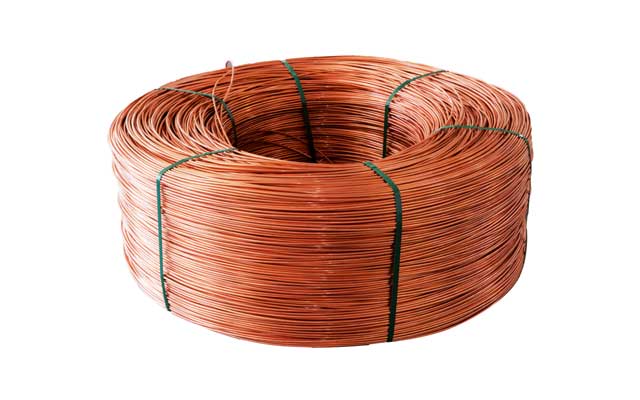Symbol CuPurity ≥99.95%Size 8.0 mmType Copper rod blanks
Copper Rod
Electrical copper rod is a cylindrical copper rod blank with a diameter of 8 mm made from cathode copper with a copper content of 99.96% or more, which is drawn by a copper wire drawing machine. It is the core raw material for producing fine copper wire.
Core Features
High conductivity: Copper has a conductivity of ≥ 58.5 × 10 ⁶ S/m (IACS 100%) and a resistivity of ≤ 0.017241 Ω· mm ²/m (20 ° C).
Excellent ductility: The soft copper rod has an elongation rate of ≥ 40% and can be pulled to a diameter of 0.01mm ultra-fine wire.
Classification
Production ProcessContinuous casting and rolling copper rod: continuous casting+hot rolling forming, high efficiency (production capacity ≥ 300000 tons/year), oxygen content of 200-400ppm (low oxygen copper).
Updrawn copper rod: oxygen free copper (OFC) is the main component, with an oxygen content of ≤ 10ppm and uniform grain size, suitable for high-frequency cables (such as 5G communication).
PurityOxygen free copper rod (OFC): purity ≥ 99.99%, oxygen content ≤ 10ppm, used for high-frequency communication cables and superconducting materials.
Low oxygen copper rod (ETP copper): purity ≥ 99.95%, oxygen content 200-400ppm, used for power cables and enameled wires.
PurposeElectrician copper rod: mainly low oxygen copper, with a large cross-sectional area (diameter 8-20mm), used for power cables and transformer windings.
Electronic copper rod: mainly made of oxygen free copper, with high purity (6N level), diameter ≤ 12 mm, used for chip bonding wires and high-frequency connectors.
Special copper rod: with irregular cross-sections (such as rectangular or hexagonal), used for motor commutators and electromagnetic shielding materials.
Manufacturing Process
The production process of copper rods varies depending on the process, with mainstream processes including continuous casting and rolling method and upward drawing method. Specifically, as follows:
Continuous Casting and Rolling Method (mainstream process, accounting for 70%):
Smelting: Electrolytic copper plate (99.99%) is melted in a vertical furnace (1150~1200 ° C) and covered with charcoal to prevent oxidation.
Continuous casting: Molten copper is injected into the continuous casting machine to form a billet with a cross-section of 150 × 150mm.
Hot rolling: The cast billet is rolled multiple times (rolling temperature 850~950 ° C) to a copper rod with a diameter of 8~20mm.
Cooling and coiling: After spray cooling, the coil is coiled into a disk with a line speed of ≥ 15m/s and a production capacity of ≥ 30 tons/hour.
Key parameters: Oxygen content of 200~400ppm, grain size ≤ 50 μm.
Upward Citation Method (specifically for high-purity oxygen free copper):
Electrolytic copper melting: Melt electrolytic copper in a medium frequency furnace (temperature 1100-1150 ° C), and protect it with nitrogen gas.
Updrawn continuous casting: Copper liquid is drawn into shape through graphite molds and cooled to form copper rods (diameter 8-12mm).
Cooling cut-off: Cut off at a fixed length after water cooling, with oxygen content ≤ 10ppm and grain size ≤ 30 μ m.
Advantages: No oxidation, fine grain size, suitable for drawing ultra-fine wires (diameter ≤ 0.03mm).
Dip Coating Molding Method (low-cost process):
Scrap copper melting: Scrap copper is melted in an induction furnace (temperature 1200-1250 ° C) with an impurity content of ≤ 0.1%.
Dip coating molding: Copper liquid is dipped onto the surface of the steel core, and after cooling, it is peeled off to obtain copper rods.
Disadvantages: High oxygen content (≥ 500ppm), surface roughness Ra ≥ 6.3 μm.
Copper Rod List
| Diameter |
Tolerance |
Elongation |
Resistivity at 20℃ |
| 8.0 mm |
±0.4 mm |
≥41% |
≤0.0170700 Q*mm²/m |
Copper Rod Application
Copper rod, as a basic material, is widely used in the following fields:
Power TransmissionOverhead conductor: Low oxygen copper rod (diameter 12-20mm) rolled into steel core aluminum stranded wire (such as JL/G1A-240/30).
Power cable: continuous casting and rolling copper rod drawn into conductors with a cross-sectional area of 25-500mm ² (such as YJV type cable).
Electronics and CommunicationHigh frequency coaxial cable: oxygen free copper rod (diameter 8mm) drawn into silver plated copper wire (skin depth optimized).
Semiconductor bonding wire: 6N high-purity copper rod (diameter 0.8mm) pulled to 18 μ m ultra-fine wire for chip packaging.
Architecture and TransportationArchitectural wire: Copper rods processed into BV wire (cross-sectional area of 1.5-6mm ²) using immersion coating method, with low cost.
Automotive wiring harness: oxygen free copper rod drawn into 0.13mm ² ultra-fine stranded wire, used for onboard sensors.
Industrial EquipmentMotor winding: Low oxygen copper rod drawn into 2-6mm enameled flat wire, with a 30% increase in slot filling rate.
Welding machine cable: high flexibility stranded wire (cross-sectional area 50-240mm ²), supporting 600A high current output.
New energy and Special FieldsPhotovoltaic welding strip: oxygen free copper rod rolled into 0.2 × 2mm thin strip, connected in series with solar cells.
Superconducting material: 6N copper rod as the substrate of superconducting tape (such as Bi-2223 high-temperature superconducting tape).


